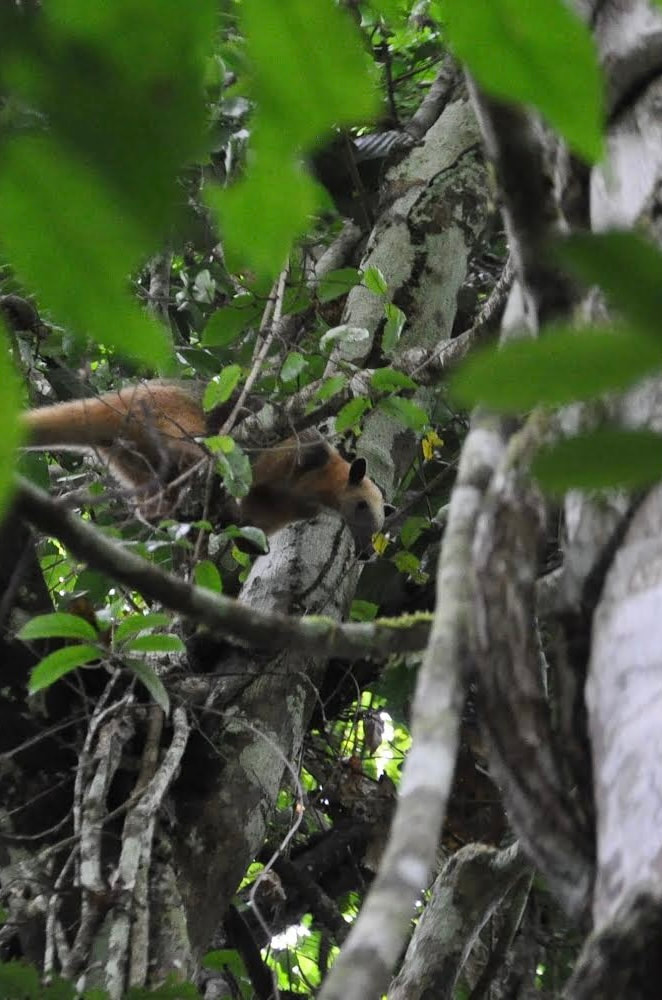The main dangers to biodiversity loss worldwide are population growth and resource consumption, global climate change, habitat loss and degradation, invasive species introduction, over-harvesting, pollution, and emerging infectious diseases. So how can we make sure that we don't lose more species, and that all levels of biological diversity are maintained? There are many solutions: both big and small.
Solutions both big and small
1. Paradigm Shift: Think Big
2. Reduce personal and corporate ecological footprints
3. Mandate corporations realize negative externalities
4. Half Earth and Rewild
5. Implement biodiversity protections into government policy at international, national, and local levels
6. Document biodiversity and its loss
7. Plant native gardens and transform your invasive grass
8. Maximize plant-based diet, buy local, and choose "sustainable" practices
9. Reduce your waste: reuse first, buy sustainable (eco-friendly) second, and educate yourself
10. Restore ecosystems
1. Paradigm Shift: Think Big
2. Reduce personal and corporate ecological footprints
3. Mandate corporations realize negative externalities
4. Half Earth and Rewild
5. Implement biodiversity protections into government policy at international, national, and local levels
6. Document biodiversity and its loss
7. Plant native gardens and transform your invasive grass
8. Maximize plant-based diet, buy local, and choose "sustainable" practices
9. Reduce your waste: reuse first, buy sustainable (eco-friendly) second, and educate yourself
10. Restore ecosystems
PARADIGM SHIFT
Maybe more important than any one decision each of us makes, we need a societal paradigm shift that stops focusing solely on infinite economic growth which doesn't value the environment or the welfare of the people. And yet, the current economic system is entirely dependent on extracting nature's resources. Instead, a shift is needed towards a system which integrates people into nature, a system that places value on both people and the environment, and one that doesn't reward those who harm the same system that we are all inextricably dependent upon. This is illustrated in the concept of Deep Ecology and is further discussed here: True Cost.
Maybe more important than any one decision each of us makes, we need a societal paradigm shift that stops focusing solely on infinite economic growth which doesn't value the environment or the welfare of the people. And yet, the current economic system is entirely dependent on extracting nature's resources. Instead, a shift is needed towards a system which integrates people into nature, a system that places value on both people and the environment, and one that doesn't reward those who harm the same system that we are all inextricably dependent upon. This is illustrated in the concept of Deep Ecology and is further discussed here: True Cost.
RESPONSIBLE CONSUMPTION
People can be encouraged and educated about what products to purchase - or not purchase - that limit their impact on the planet. For example, see how eating meat greatly increases your impact, or the use of non-certified palm oil contributes to deforestation. And your impact isn't limited to food. Consider that having another child, driving your car, and trans-Atlantic flights all contribute significant amounts of CO2 to the atmosphere. There are no shortage of ways to limit your impact by changing behavior. But recent research suggests that people are willing to adjust their consumption if given enough information: Carbon Footprint Labeling Impacts Shopper Behavior
We need top-down government imposed policies that help increase efficiency and limit consumption of resources that are threatened. And through these policies, carbon consumption can be drastically reduced, limiting the catastrophic impacts of anthropogenic global climate change. This is why we need consumption-based policies. These policies are designed to discourage the consumption of carbon-intensive products and services. Governments can enact carbon consumption taxes, which tax products on their carbon intensity, irrespective of where they were produced. This would require a carbon tax at home, and border adjustment tax on imports. To mobilize the support of the business community, the carbon tax might be designed to be revenue-neutral: that is, accompanied by tax cuts elsewhere. This would likely need to take into account the true cost of services and products. For example, emissions from burning gasoline are attributed to the person who owns the car. But emissions generated in the process of manufacturing this car abroad are not. We refer to this as the True Cost. Of course, carbon is only part of the problem. Governments need to ramp up investment in nature restoration and raise the tax burden on companies that degrade wildlife and nature (Watts 2019).
Other ideas include consumption-focused policies such as carbon taxes and carbon labels which would allow consumers to make informed choices and creates incentives for producers to respond to these choices. Other steps you can take:
ZERO DEFORESTATION POLICIES
Companies can make an impact by introducing “zero deforestation” policies that clean up their supply chains. That means holding their suppliers accountable for producing commodities like timber, beef, soy, palm oil and paper in a way that does not fuel deforestation and has a minimal impact on our climate. Companies should set ambitious targets to maximize the use of recycled wood, pulp, paper and fiber in their products.
Consumers should be encouraged to make informed decisions about the products that they purchase. People can make a difference by consuming less, eating sustainable food, and choosing recycled or certified sustainable wood products. For example, consumption of non-certified palm-oil is having a devastating impact on tropical forests.
HALF EARTH
Introduction of protected areas has had solid success in some areas, protecting resources that would otherwise have been extracted. In fact, the Half Earth strategy is designed to protect half the planet in hopes of avoiding a global extinction crisis. Why one-half? "The crucial factor in the life and death of species is the amount of suitable habitat left to them. As defined by the theory of island biogeography, a change in area of a habitat results in a change in the sustainable number of species by approximately the fourth root. As reserves grow in size, the diversity of life surviving within them also grows. As reserves are reduced in area, the diversity within them declines to a mathematically predictable degree swiftly – often immediately and, for a large fraction, forever (Discover Half Earth)." However, the success of these protected areas is largely dependent on design.
There is sufficient evidence to support habitat restoration as a tool in combating climate change. However, it should be noted that mass planting of trees - without taking into account the actual restoration of ecological systems - does not necessarily benefit wildlife and may do little to eliminate species extinction. For example, some areas are far more important than others (i.e., biodiversity hot spots).
Similarly, another approach is community-based conservation which may also be successful, but does depend on certain criteria.
And lastly, governments need to crack down on corruption and ensure fair enforcement of forest conservation rules. Corruption fuels illegal logging and unsustainable forest management, which in turn can fuel organized crime or even armed conflict. We also need world leaders to embrace ambitious domestic and international forest conservation policies based on the latest science.
People can be encouraged and educated about what products to purchase - or not purchase - that limit their impact on the planet. For example, see how eating meat greatly increases your impact, or the use of non-certified palm oil contributes to deforestation. And your impact isn't limited to food. Consider that having another child, driving your car, and trans-Atlantic flights all contribute significant amounts of CO2 to the atmosphere. There are no shortage of ways to limit your impact by changing behavior. But recent research suggests that people are willing to adjust their consumption if given enough information: Carbon Footprint Labeling Impacts Shopper Behavior
We need top-down government imposed policies that help increase efficiency and limit consumption of resources that are threatened. And through these policies, carbon consumption can be drastically reduced, limiting the catastrophic impacts of anthropogenic global climate change. This is why we need consumption-based policies. These policies are designed to discourage the consumption of carbon-intensive products and services. Governments can enact carbon consumption taxes, which tax products on their carbon intensity, irrespective of where they were produced. This would require a carbon tax at home, and border adjustment tax on imports. To mobilize the support of the business community, the carbon tax might be designed to be revenue-neutral: that is, accompanied by tax cuts elsewhere. This would likely need to take into account the true cost of services and products. For example, emissions from burning gasoline are attributed to the person who owns the car. But emissions generated in the process of manufacturing this car abroad are not. We refer to this as the True Cost. Of course, carbon is only part of the problem. Governments need to ramp up investment in nature restoration and raise the tax burden on companies that degrade wildlife and nature (Watts 2019).
Other ideas include consumption-focused policies such as carbon taxes and carbon labels which would allow consumers to make informed choices and creates incentives for producers to respond to these choices. Other steps you can take:
- Shrink your carbon profile. You can offset the carbon you produce by purchasing carbon offsets, which represent clean power that you can add to the nation’s energy grid in place of power from fossil fuels. But not all carbon offset companies are alike. Do your homework to find the best supplier. (Source: How You Can Stop Global Warming, NRDC)
- Vote for those that support environmentally responsible legislation
ZERO DEFORESTATION POLICIES
Companies can make an impact by introducing “zero deforestation” policies that clean up their supply chains. That means holding their suppliers accountable for producing commodities like timber, beef, soy, palm oil and paper in a way that does not fuel deforestation and has a minimal impact on our climate. Companies should set ambitious targets to maximize the use of recycled wood, pulp, paper and fiber in their products.
Consumers should be encouraged to make informed decisions about the products that they purchase. People can make a difference by consuming less, eating sustainable food, and choosing recycled or certified sustainable wood products. For example, consumption of non-certified palm-oil is having a devastating impact on tropical forests.
HALF EARTH
Introduction of protected areas has had solid success in some areas, protecting resources that would otherwise have been extracted. In fact, the Half Earth strategy is designed to protect half the planet in hopes of avoiding a global extinction crisis. Why one-half? "The crucial factor in the life and death of species is the amount of suitable habitat left to them. As defined by the theory of island biogeography, a change in area of a habitat results in a change in the sustainable number of species by approximately the fourth root. As reserves grow in size, the diversity of life surviving within them also grows. As reserves are reduced in area, the diversity within them declines to a mathematically predictable degree swiftly – often immediately and, for a large fraction, forever (Discover Half Earth)." However, the success of these protected areas is largely dependent on design.
There is sufficient evidence to support habitat restoration as a tool in combating climate change. However, it should be noted that mass planting of trees - without taking into account the actual restoration of ecological systems - does not necessarily benefit wildlife and may do little to eliminate species extinction. For example, some areas are far more important than others (i.e., biodiversity hot spots).
Similarly, another approach is community-based conservation which may also be successful, but does depend on certain criteria.
And lastly, governments need to crack down on corruption and ensure fair enforcement of forest conservation rules. Corruption fuels illegal logging and unsustainable forest management, which in turn can fuel organized crime or even armed conflict. We also need world leaders to embrace ambitious domestic and international forest conservation policies based on the latest science.
REWILDING
Rewilding is a novel approach to ecological restoration and biodiversity conservation that has gained increasing attention in recent years. It seeks to restore ecosystems to their natural state by reducing human intervention and promoting the recovery of key species. Rewilding is a multifaceted concept that involves restoring natural processes and increasing biodiversity through minimal human intervention. It encourages the return of keystone species and the development of trophic cascades.
Rewilding concepts: 1) Passive management emphasizes allowing natural processes to take place without extensive human interference, which can include controlled burns, invasive species removal, and habitat restoration. 2) Rewilding often focuses on reintroducing or protecting keystone species that have a disproportionate impact on the ecosystem, such as wolves, beavers, or apex predators. 3) Rewilding projects often encompass large landscapes, ensuring connectivity between fragmented habitats to support wildlife migration and gene flow. 4) Human intervention is limited to actions that are necessary to kickstart ecological processes, with an emphasis on non-intrusive approaches.
Benefits of Rewilding: Rewilding efforts have successfully reintroduced endangered species, such as the European bison, California condor, and Iberian lynx, back into their native habitats. By allowing natural selection to operate, rewilding contributes to the genetic diversity and adaptability of species.
Rewilding is a novel approach to ecological restoration and biodiversity conservation that has gained increasing attention in recent years. It seeks to restore ecosystems to their natural state by reducing human intervention and promoting the recovery of key species. Rewilding is a multifaceted concept that involves restoring natural processes and increasing biodiversity through minimal human intervention. It encourages the return of keystone species and the development of trophic cascades.
Rewilding concepts: 1) Passive management emphasizes allowing natural processes to take place without extensive human interference, which can include controlled burns, invasive species removal, and habitat restoration. 2) Rewilding often focuses on reintroducing or protecting keystone species that have a disproportionate impact on the ecosystem, such as wolves, beavers, or apex predators. 3) Rewilding projects often encompass large landscapes, ensuring connectivity between fragmented habitats to support wildlife migration and gene flow. 4) Human intervention is limited to actions that are necessary to kickstart ecological processes, with an emphasis on non-intrusive approaches.
Benefits of Rewilding: Rewilding efforts have successfully reintroduced endangered species, such as the European bison, California condor, and Iberian lynx, back into their native habitats. By allowing natural selection to operate, rewilding contributes to the genetic diversity and adaptability of species.
RESTORATION ECOLOGY
Restoration ecology involves restoring degraded, damaged, or destroyed ecosystems. One of the primary goals of restoration ecology is to recreate or enhance habitats for diverse plant and animal species. Human activities such as deforestation, pollution, and habitat destruction have significantly impacted these environments. Restoration projects target the reestablishment of critical habitats, providing refuge, food sources, and breeding grounds for a variety of fauna. This emphasis on habitat restoration directly contributes to the recovery of numerous animal species, preventing their decline and facilitating the restoration of ecological balance. The reintroduction of native plant species, a common practice in restoration projects, is instrumental in promoting biodiversity. As native plants flourish, they create a mosaic of habitats that attracts a variety of fauna, from insects and birds to larger mammals. This approach aids in the natural regeneration of ecosystems, allowing fauna to thrive and promoting a balanced and resilient environment. Restoration efforts often consider the creation of ecological corridors to connect fragmented habitats. These corridors act as pathways for the movement of species, allowing for genetic exchange and supporting biodiversity. The re-establishment of connectivity ensures that flora and fauna can migrate, adapt to changing conditions, and maintain genetic diversity within their populations.
In a world facing rapid environmental changes, restoration ecology helps ecosystems adapt. By reintroducing native species and creating resilient habitats, restoration enhances the ability of ecosystems to withstand disturbances, such as extreme weather events and invasive species, promoting their long-term viability.
Restoration ecology involves restoring degraded, damaged, or destroyed ecosystems. One of the primary goals of restoration ecology is to recreate or enhance habitats for diverse plant and animal species. Human activities such as deforestation, pollution, and habitat destruction have significantly impacted these environments. Restoration projects target the reestablishment of critical habitats, providing refuge, food sources, and breeding grounds for a variety of fauna. This emphasis on habitat restoration directly contributes to the recovery of numerous animal species, preventing their decline and facilitating the restoration of ecological balance. The reintroduction of native plant species, a common practice in restoration projects, is instrumental in promoting biodiversity. As native plants flourish, they create a mosaic of habitats that attracts a variety of fauna, from insects and birds to larger mammals. This approach aids in the natural regeneration of ecosystems, allowing fauna to thrive and promoting a balanced and resilient environment. Restoration efforts often consider the creation of ecological corridors to connect fragmented habitats. These corridors act as pathways for the movement of species, allowing for genetic exchange and supporting biodiversity. The re-establishment of connectivity ensures that flora and fauna can migrate, adapt to changing conditions, and maintain genetic diversity within their populations.
In a world facing rapid environmental changes, restoration ecology helps ecosystems adapt. By reintroducing native species and creating resilient habitats, restoration enhances the ability of ecosystems to withstand disturbances, such as extreme weather events and invasive species, promoting their long-term viability.
FAMILY PLANNING AND EDUCATION
- Provide universal access to safe and effective contraceptive options for both sexes. With nearly two in five pregnancies reported as mistimed or never wanted, lack of access to good family planning services is among the biggest gaps in assuring that each baby will be wanted and welcomed in advance by its parents.
- Guarantee education through at least secondary school for all. In every culture surveyed to date, women who have completed at least some secondary school have fewer children on average, and have children later in life, than do women who have less education.
- Eradicate gender bias from law, economic opportunity, health, and culture. Women who can own, inherit, and manage property; divorce; obtain credit; and participate in civic and political affairs on equal terms with men are more likely to postpone childbearing and to have fewer children compared to women who are deprived of these rights.
- Offer age-appropriate sexuality education for all students. Data from the United States indicate that exposure to comprehensive programs that detail puberty, intercourse, options of abstinence and birth control, and respecting the sexual rights and decisions of individuals, can help prevent unwanted pregnancies and hence reduce birth rates.
- End all policies that reward parents financially based on the number of children they have. Governments can preserve and even increase tax and other financial benefits aimed at helping parents by linking these not to the number of children they have, but rather to effective parenting.
- Integrate lessons on population, environment, and development into school curricula at multiple levels. Refraining from advocacy or propaganda, schools should educate students to make well-informed choices about the impacts of their behavior, including childbearing, on the environment.
- Put prices on environmental costs and impacts. In quantifying the cost of an additional family member by calculating taxes and increased food costs, couples may decide that the cost of having an additional child is too high, compared to the benefits of a smaller family that might receive government rebates and have a lower cost of living. Such decisions, freely made by women and couples, can decrease birth rates without any involvement by outside entities.
- Adjust to an aging population instead of boosting childbearing through government incentives and programs. Population aging must be met with the needed societal adjustments, such as increased labor participation, rather than by encouraging women to simply have more children.
- Convince leaders to commit to stabilizing population growth through the exercise of human rights and human development. By educating themselves on rights-based population policies, policymakers can ethically and effectively address population-related challenges by empowering women to make their reproductive choices. (Source: Nine Population Strategies to Stop Short of 9 Billion: Worldwatch)
There is no one solution and likely the answer involves both top-down government action plans and a change in mindset of individuals worldwide to ignite change locally. In either case, change starts with people voicing their concerns with legislators, changing consumption habits, and leading by example.
Sources
- Bradshaw, C. J., & Brook, B. W. (2014). Human population reduction is not a quick fix for environmental problems. Proceedings of the National Academy of Sciences, 111(46), 16610-16615.
- Gordon, A., Simondson, D., White, M., Moilanen, A., & Bekessy, S. A. (2009). Integrating conservation planning and landuse planning in urban landscapes. Landscape and urban planning, 91(4), 183-194.
- Spears, D. (2015). Smaller human population in 2100 could importantly reduce the risk of climate catastrophe. Proceedings of the National Academy of Sciences, 112(18), E2270-E2270.
- O'neill, B. C., Dalton, M., Fuchs, R., Jiang, L., Pachauri, S., & Zigova, K. (2010). Global demographic trends and future carbon emissions. Proceedings of the National Academy of Sciences, 201004581.






